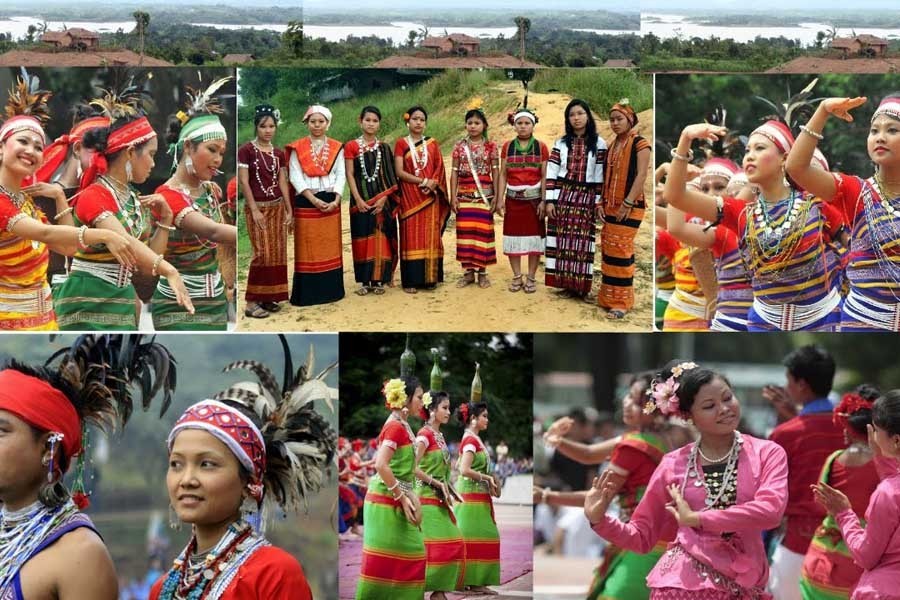
Published :
Updated :

Due mainly to their fast dwindling in number, the plain-land indigenous communities in Bangladesh generally remain out of focus even on the international days on these long exploited people. Compared to the indigenous populations living in the south-eastern hilly areas of the country, the lives of the plain-land tribes are perennially filled with miseries. Thus began the process of their marginalisation in the country's socio-economic structure. Later, this social degradation has led to the near-pauperisation of many in these communities. This process was expedited by the influential and greedy people in rural societies. At one point, even the faint glimpses of a better life began emerging elusive to them. These indigenous communities comprise mainly the Santals, Oraons, Mundas, Mahalis, Pahans, Barmans, Koras and Mushors --- and a large number of relatively better-off Garos and Hajongs. The latter two communities live in the greater Netrokona and Jamalpur districts.
Against this backdrop, the International Day of the World's Indigenous Peoples appears every early August with a grim portrayal of them. However, different organisations try their best to give the day's observance a festive look. And the celebrations remain mostly limited to the urban areas, the capital being the chief venue. Few in the tribal communities living in the country for centuries, feel akin to these celebrations. Their rather mirthless faces and robotesque participation speak volumes about the anxiety-filled sadness permeating their subconscious.
The scenario is more or less similar in every part of Bangladesh having plain-land indigenous communities. Apart from being hit lately by the ravages and fallout of the novel coronavirus, these people have for decades been plagued by all types of discrimination. Ranging from work and employment opportunities, education, women's empowerment, medical facilities --- virtually all sectors remain off-limits to the plain-land tribes. Despite the relentless campaigns conducted by human rights activists, there are little signs of any positive change. A study conducted by a local think tank and a UN agency says that a number of socio-economic indicators like healthcare, education, house-hold level income, food consumption etc remain below the national average for indigenous peoples. A break-up shows that the poverty rate among the plain-land indigenous peoples is nearly 80 per cent. In the Chattogram Hill Tracts(CHT) it is around 65 per cent.
After the outbreak of the corona pandemic among the smaller ethnic groups, their ostracising staged a comeback with vengeance. Luckily, the prevalence of the corona scourge has not flared up alarmingly among the plain-land indigenous groups. Nonetheless, these ethnic groups could not fully escape the impacts of the pandemic.
After coming out of the full-blown ordeals of the pandemic nearly unscathed, the plain-land indigenous communities now brace for the ways of how to deal with the corona fallout. It's unanimously accepted that the indigenous peoples in Bangladesh have been hit hard by both economic jolts and dozens of social disruptions caused by the pandemic. Following the sudden bouts of job losses the spectre of a protracted phase of unemployment looms menacingly. Apart from petty jobs, the small-capital enterprises run by both males and females are feared to get stuck in the maze of uncertainties. Actually, it was the long corona shutdown the plain-land indigenous communities had dreaded the most. As had been admitted by many of them, they were not scared of the pandemic as much as they were of its impacts on their lives. The picture that emerges is one filled with gloom.
In the less developed countries like Bangladesh, the underprivileged and socio-economically deprived indigenous communities have been hit by Covid-19 irrespective of their concentration in the remote and far-flung areas or the prime areas in the mainland. There are exceptions, too. When it comes to the CHT, people living close to its semi-urban areas have been detected as being worst-hit by Covid-19. As part of the continuously mutating nature of the virus, the indigenous communities settled in the outlying and remote hilly regions are found tolerably free of the pandemic's onslaught. Whatever the extent of the pandemic ferocity is, it's true that the indigenous peoples of the country in general have been hit by its outbreak and its fallout --- the brunt being borne by the plain-land ethnic communities in particular.
Already the indigenous peoples living in the plains have for ages been plagued by encroachment on their ancestral croplands and homesteads, marginalisation, limiting entries to work, impeding the inclusion of children in their basic education etc. In the 21st century, many of the plain-land smaller ethnic communities are barely existent. Thanks to a lack of social cohesion aggravated by the machinations of unscrupulous segments of mainlanders, lots of these indigenous communities have long been on the verge of extinction. That there are still over a dozen such indigenous peoples living in the country is being consigned to oblivion by both the policymakers and the general people. A number of plainland indigenous communities are recognised by ethnologists as being the earliest of the land's settlers. The nation cannot afford to overlook this episode leading to the evolution of Bengalees as a unique racial entity. All this warrants a radical change in attitude of the majority towards the minor ethnic segments.


 For all latest news, follow The Financial Express Google News channel.
For all latest news, follow The Financial Express Google News channel.